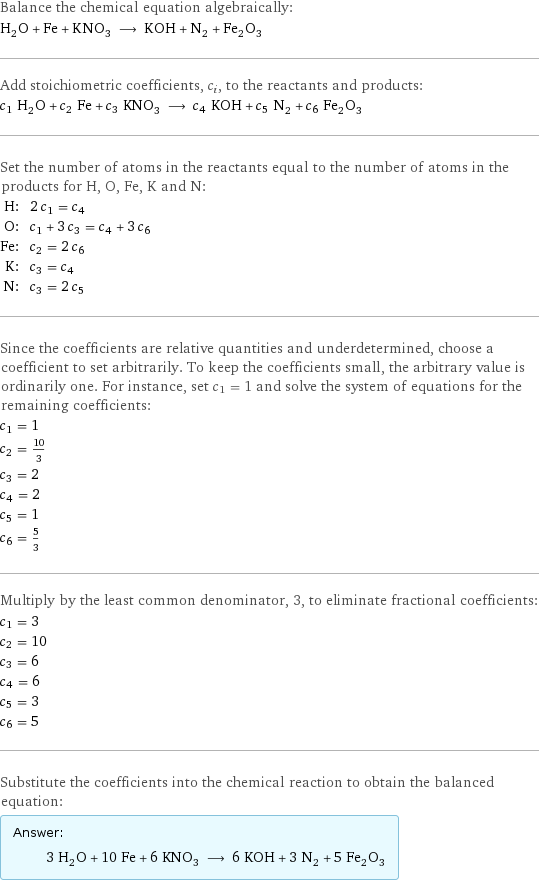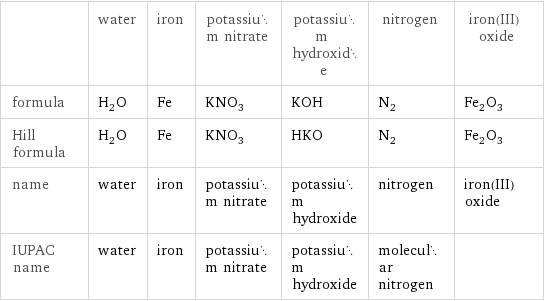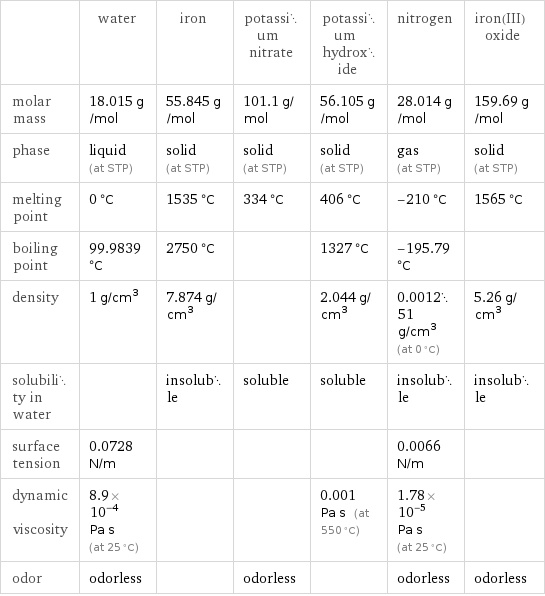Input interpretation

H_2O water + Fe iron + KNO_3 potassium nitrate ⟶ KOH potassium hydroxide + N_2 nitrogen + Fe_2O_3 iron(III) oxide
Balanced equation

Balance the chemical equation algebraically: H_2O + Fe + KNO_3 ⟶ KOH + N_2 + Fe_2O_3 Add stoichiometric coefficients, c_i, to the reactants and products: c_1 H_2O + c_2 Fe + c_3 KNO_3 ⟶ c_4 KOH + c_5 N_2 + c_6 Fe_2O_3 Set the number of atoms in the reactants equal to the number of atoms in the products for H, O, Fe, K and N: H: | 2 c_1 = c_4 O: | c_1 + 3 c_3 = c_4 + 3 c_6 Fe: | c_2 = 2 c_6 K: | c_3 = c_4 N: | c_3 = 2 c_5 Since the coefficients are relative quantities and underdetermined, choose a coefficient to set arbitrarily. To keep the coefficients small, the arbitrary value is ordinarily one. For instance, set c_1 = 1 and solve the system of equations for the remaining coefficients: c_1 = 1 c_2 = 10/3 c_3 = 2 c_4 = 2 c_5 = 1 c_6 = 5/3 Multiply by the least common denominator, 3, to eliminate fractional coefficients: c_1 = 3 c_2 = 10 c_3 = 6 c_4 = 6 c_5 = 3 c_6 = 5 Substitute the coefficients into the chemical reaction to obtain the balanced equation: Answer: | | 3 H_2O + 10 Fe + 6 KNO_3 ⟶ 6 KOH + 3 N_2 + 5 Fe_2O_3
Structures

+ + ⟶ + +
Names

water + iron + potassium nitrate ⟶ potassium hydroxide + nitrogen + iron(III) oxide
Reaction thermodynamics
Enthalpy

| water | iron | potassium nitrate | potassium hydroxide | nitrogen | iron(III) oxide molecular enthalpy | -285.8 kJ/mol | 0 kJ/mol | -494.6 kJ/mol | -424.6 kJ/mol | 0 kJ/mol | -826 kJ/mol total enthalpy | -857.5 kJ/mol | 0 kJ/mol | -2968 kJ/mol | -2548 kJ/mol | 0 kJ/mol | -4130 kJ/mol | H_initial = -3825 kJ/mol | | | H_final = -6678 kJ/mol | | ΔH_rxn^0 | -6678 kJ/mol - -3825 kJ/mol = -2853 kJ/mol (exothermic) | | | | |
Equilibrium constant
![Construct the equilibrium constant, K, expression for: H_2O + Fe + KNO_3 ⟶ KOH + N_2 + Fe_2O_3 Plan: • Balance the chemical equation. • Determine the stoichiometric numbers. • Assemble the activity expression for each chemical species. • Use the activity expressions to build the equilibrium constant expression. Write the balanced chemical equation: 3 H_2O + 10 Fe + 6 KNO_3 ⟶ 6 KOH + 3 N_2 + 5 Fe_2O_3 Assign stoichiometric numbers, ν_i, using the stoichiometric coefficients, c_i, from the balanced chemical equation in the following manner: ν_i = -c_i for reactants and ν_i = c_i for products: chemical species | c_i | ν_i H_2O | 3 | -3 Fe | 10 | -10 KNO_3 | 6 | -6 KOH | 6 | 6 N_2 | 3 | 3 Fe_2O_3 | 5 | 5 Assemble the activity expressions accounting for the state of matter and ν_i: chemical species | c_i | ν_i | activity expression H_2O | 3 | -3 | ([H2O])^(-3) Fe | 10 | -10 | ([Fe])^(-10) KNO_3 | 6 | -6 | ([KNO3])^(-6) KOH | 6 | 6 | ([KOH])^6 N_2 | 3 | 3 | ([N2])^3 Fe_2O_3 | 5 | 5 | ([Fe2O3])^5 The equilibrium constant symbol in the concentration basis is: K_c Mulitply the activity expressions to arrive at the K_c expression: Answer: | | K_c = ([H2O])^(-3) ([Fe])^(-10) ([KNO3])^(-6) ([KOH])^6 ([N2])^3 ([Fe2O3])^5 = (([KOH])^6 ([N2])^3 ([Fe2O3])^5)/(([H2O])^3 ([Fe])^10 ([KNO3])^6)](../image_source/a22a8f6f58ba915a3004a1ecea7b8d8f.png)
Construct the equilibrium constant, K, expression for: H_2O + Fe + KNO_3 ⟶ KOH + N_2 + Fe_2O_3 Plan: • Balance the chemical equation. • Determine the stoichiometric numbers. • Assemble the activity expression for each chemical species. • Use the activity expressions to build the equilibrium constant expression. Write the balanced chemical equation: 3 H_2O + 10 Fe + 6 KNO_3 ⟶ 6 KOH + 3 N_2 + 5 Fe_2O_3 Assign stoichiometric numbers, ν_i, using the stoichiometric coefficients, c_i, from the balanced chemical equation in the following manner: ν_i = -c_i for reactants and ν_i = c_i for products: chemical species | c_i | ν_i H_2O | 3 | -3 Fe | 10 | -10 KNO_3 | 6 | -6 KOH | 6 | 6 N_2 | 3 | 3 Fe_2O_3 | 5 | 5 Assemble the activity expressions accounting for the state of matter and ν_i: chemical species | c_i | ν_i | activity expression H_2O | 3 | -3 | ([H2O])^(-3) Fe | 10 | -10 | ([Fe])^(-10) KNO_3 | 6 | -6 | ([KNO3])^(-6) KOH | 6 | 6 | ([KOH])^6 N_2 | 3 | 3 | ([N2])^3 Fe_2O_3 | 5 | 5 | ([Fe2O3])^5 The equilibrium constant symbol in the concentration basis is: K_c Mulitply the activity expressions to arrive at the K_c expression: Answer: | | K_c = ([H2O])^(-3) ([Fe])^(-10) ([KNO3])^(-6) ([KOH])^6 ([N2])^3 ([Fe2O3])^5 = (([KOH])^6 ([N2])^3 ([Fe2O3])^5)/(([H2O])^3 ([Fe])^10 ([KNO3])^6)
Rate of reaction
![Construct the rate of reaction expression for: H_2O + Fe + KNO_3 ⟶ KOH + N_2 + Fe_2O_3 Plan: • Balance the chemical equation. • Determine the stoichiometric numbers. • Assemble the rate term for each chemical species. • Write the rate of reaction expression. Write the balanced chemical equation: 3 H_2O + 10 Fe + 6 KNO_3 ⟶ 6 KOH + 3 N_2 + 5 Fe_2O_3 Assign stoichiometric numbers, ν_i, using the stoichiometric coefficients, c_i, from the balanced chemical equation in the following manner: ν_i = -c_i for reactants and ν_i = c_i for products: chemical species | c_i | ν_i H_2O | 3 | -3 Fe | 10 | -10 KNO_3 | 6 | -6 KOH | 6 | 6 N_2 | 3 | 3 Fe_2O_3 | 5 | 5 The rate term for each chemical species, B_i, is 1/ν_i(Δ[B_i])/(Δt) where [B_i] is the amount concentration and t is time: chemical species | c_i | ν_i | rate term H_2O | 3 | -3 | -1/3 (Δ[H2O])/(Δt) Fe | 10 | -10 | -1/10 (Δ[Fe])/(Δt) KNO_3 | 6 | -6 | -1/6 (Δ[KNO3])/(Δt) KOH | 6 | 6 | 1/6 (Δ[KOH])/(Δt) N_2 | 3 | 3 | 1/3 (Δ[N2])/(Δt) Fe_2O_3 | 5 | 5 | 1/5 (Δ[Fe2O3])/(Δt) (for infinitesimal rate of change, replace Δ with d) Set the rate terms equal to each other to arrive at the rate expression: Answer: | | rate = -1/3 (Δ[H2O])/(Δt) = -1/10 (Δ[Fe])/(Δt) = -1/6 (Δ[KNO3])/(Δt) = 1/6 (Δ[KOH])/(Δt) = 1/3 (Δ[N2])/(Δt) = 1/5 (Δ[Fe2O3])/(Δt) (assuming constant volume and no accumulation of intermediates or side products)](../image_source/1fa37e22a426fea869409e7f2b0e8eef.png)
Construct the rate of reaction expression for: H_2O + Fe + KNO_3 ⟶ KOH + N_2 + Fe_2O_3 Plan: • Balance the chemical equation. • Determine the stoichiometric numbers. • Assemble the rate term for each chemical species. • Write the rate of reaction expression. Write the balanced chemical equation: 3 H_2O + 10 Fe + 6 KNO_3 ⟶ 6 KOH + 3 N_2 + 5 Fe_2O_3 Assign stoichiometric numbers, ν_i, using the stoichiometric coefficients, c_i, from the balanced chemical equation in the following manner: ν_i = -c_i for reactants and ν_i = c_i for products: chemical species | c_i | ν_i H_2O | 3 | -3 Fe | 10 | -10 KNO_3 | 6 | -6 KOH | 6 | 6 N_2 | 3 | 3 Fe_2O_3 | 5 | 5 The rate term for each chemical species, B_i, is 1/ν_i(Δ[B_i])/(Δt) where [B_i] is the amount concentration and t is time: chemical species | c_i | ν_i | rate term H_2O | 3 | -3 | -1/3 (Δ[H2O])/(Δt) Fe | 10 | -10 | -1/10 (Δ[Fe])/(Δt) KNO_3 | 6 | -6 | -1/6 (Δ[KNO3])/(Δt) KOH | 6 | 6 | 1/6 (Δ[KOH])/(Δt) N_2 | 3 | 3 | 1/3 (Δ[N2])/(Δt) Fe_2O_3 | 5 | 5 | 1/5 (Δ[Fe2O3])/(Δt) (for infinitesimal rate of change, replace Δ with d) Set the rate terms equal to each other to arrive at the rate expression: Answer: | | rate = -1/3 (Δ[H2O])/(Δt) = -1/10 (Δ[Fe])/(Δt) = -1/6 (Δ[KNO3])/(Δt) = 1/6 (Δ[KOH])/(Δt) = 1/3 (Δ[N2])/(Δt) = 1/5 (Δ[Fe2O3])/(Δt) (assuming constant volume and no accumulation of intermediates or side products)
Chemical names and formulas

| water | iron | potassium nitrate | potassium hydroxide | nitrogen | iron(III) oxide formula | H_2O | Fe | KNO_3 | KOH | N_2 | Fe_2O_3 Hill formula | H_2O | Fe | KNO_3 | HKO | N_2 | Fe_2O_3 name | water | iron | potassium nitrate | potassium hydroxide | nitrogen | iron(III) oxide IUPAC name | water | iron | potassium nitrate | potassium hydroxide | molecular nitrogen |
Substance properties

| water | iron | potassium nitrate | potassium hydroxide | nitrogen | iron(III) oxide molar mass | 18.015 g/mol | 55.845 g/mol | 101.1 g/mol | 56.105 g/mol | 28.014 g/mol | 159.69 g/mol phase | liquid (at STP) | solid (at STP) | solid (at STP) | solid (at STP) | gas (at STP) | solid (at STP) melting point | 0 °C | 1535 °C | 334 °C | 406 °C | -210 °C | 1565 °C boiling point | 99.9839 °C | 2750 °C | | 1327 °C | -195.79 °C | density | 1 g/cm^3 | 7.874 g/cm^3 | | 2.044 g/cm^3 | 0.001251 g/cm^3 (at 0 °C) | 5.26 g/cm^3 solubility in water | | insoluble | soluble | soluble | insoluble | insoluble surface tension | 0.0728 N/m | | | | 0.0066 N/m | dynamic viscosity | 8.9×10^-4 Pa s (at 25 °C) | | | 0.001 Pa s (at 550 °C) | 1.78×10^-5 Pa s (at 25 °C) | odor | odorless | | odorless | | odorless | odorless
Units
